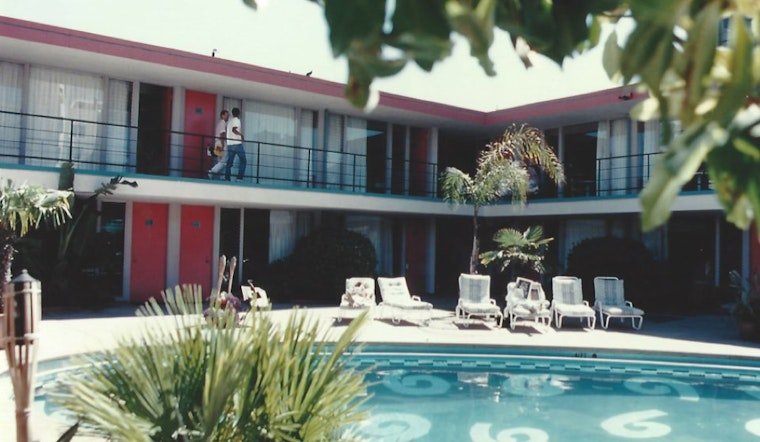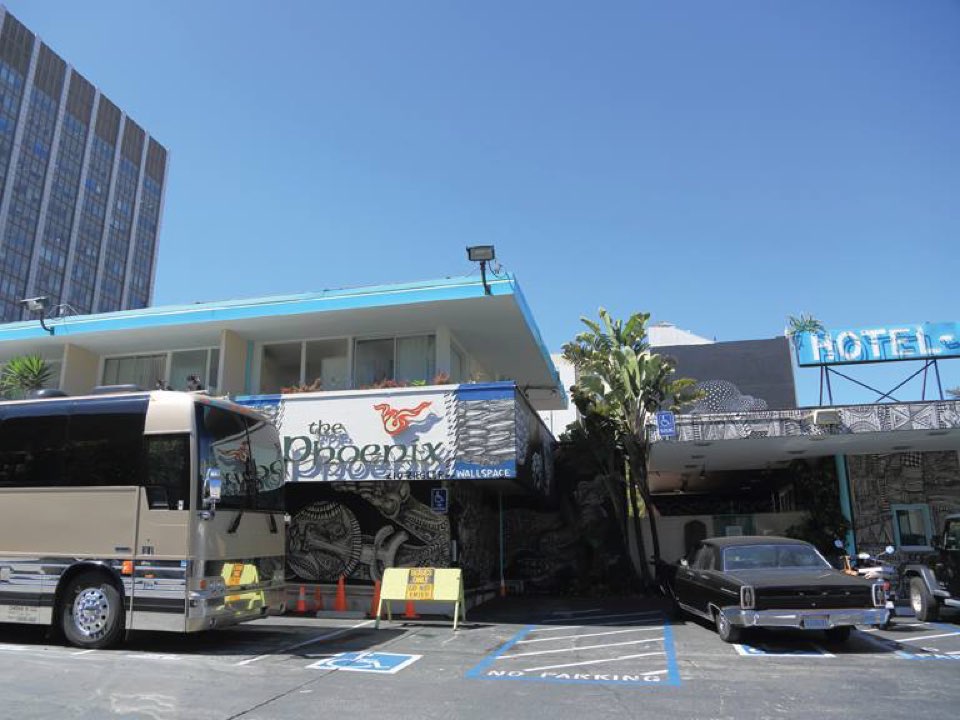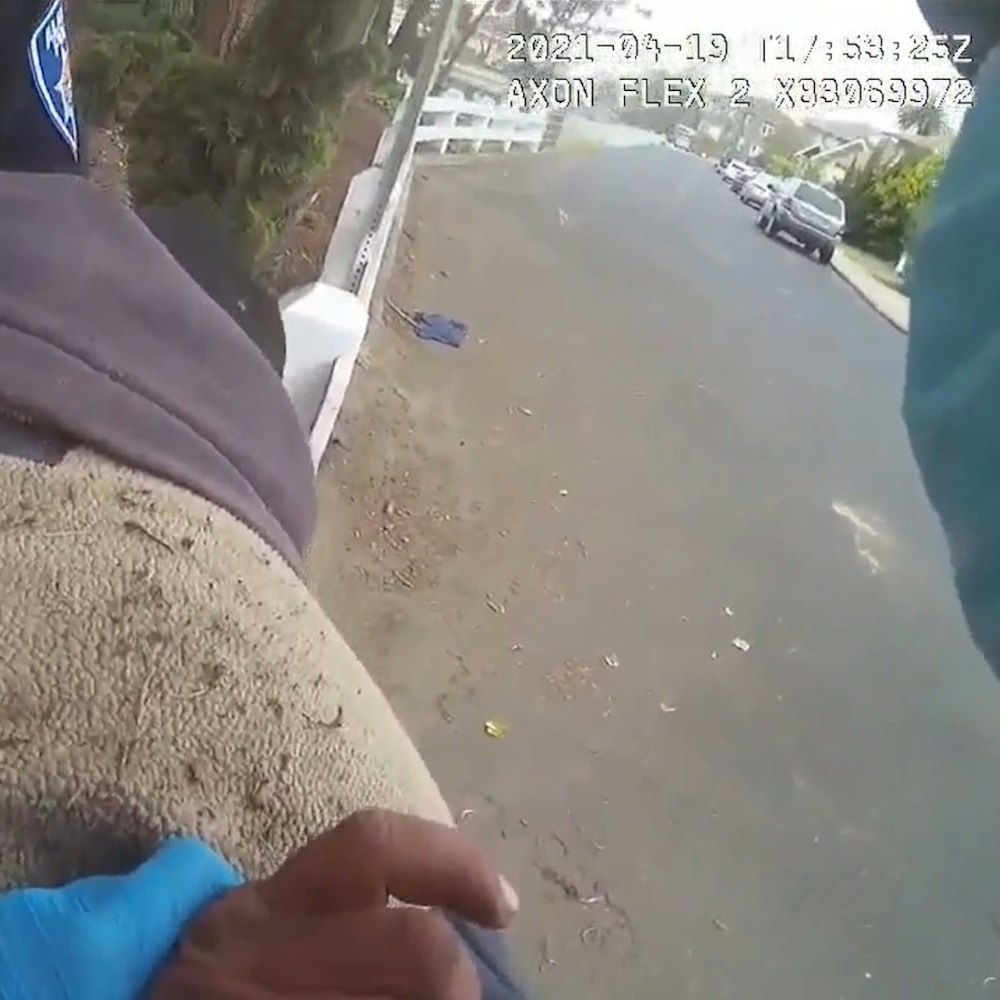
In 1987, a 26-year-old with a bit of commercial real estate experience took over a seedy pay-by-the-hour motel on the edge of the Tenderloin. “My first reaction when I walked into it was, ‘This is a great place to throw a party,’” said Chip Conley of what is now the Phoenix Hotel, at 601 Eddy St.
Formerly known as the Caravan Lodge, the hotel was founded in 1960 as a Palm Springs-style retreat, attracting everyone from Buddy Hackett to Neil Young. (Before that, it was a parking garage and a drive-in; here's a postcard of it in its swinging '60s heyday.)
Over the course of the '70s and '80s, the hotel grew seedy, but Conley wanted to restore it to its former glory, which is why he chose the Phoenix, symbol of rebirth, as its moniker. In the '90s and onward, Conley and his team made the Phoenix a destination for some of the era’s greatest rock ’n roll bands, before spreading their wings to become the nation’s second largest boutique hotel operator, Joie de Vivre.
Conley—who sold Joie de Vivre but continues to own a few of its hotels, including the Phoenix—returned to the Tenderloin last week for an intimate Q&A session with Randy Shaw, founder of the Tenderloin Museum. During the 90-minute discussion, Conley shared a number of surprising facts about his earliest days at the neighborhood landmark.
The key to driving bands to your door: free massages.

Identifying your target market’s decision-maker is the key to finding success, Conley told the crowd. For an aspiring rock 'n roll hotel, that person is the tour manager, who's in charge of making sure that band members arrive at their gigs on time, get some sleep and don’t overdose.
When the Phoenix Hotel was getting started, there were just 100 tour managers working with rock bands nationwide, Conley said. To entice these obviously stressed individuals to book rooms with the Phoenix, he launched a promotion: any tour manager who booked at least five rooms for two-night stays received a free massage in the onsite massage treatment room.
Word got around in just a few months, and tour managers for the likes of David Bowie, the Red Hot Chili Peppers, Pearl Jam, and Nirvana all began cashing in on the free massages. An additional selling point: free bus parking.
Not a single room at the Phoenix has been trashed.

A room at the Phoenix. (Photo: Phoenix Hotel/Facebook)
The Phoenix Hotel is designed for partiers, and bands loved the ability to hang out in the courtyard and pool with their members and groupies, Conley said. Unbelievably, though, not a single band in the hotel's 29-year history has trashed one of its rooms.
Conley said that hospitality is to thank. While other hotels forced bands to sign damage waivers before handing over the keys, he thought, "What if you treated band members like friends who are staying in your home?" That included labeling front-desk clerks "hosts" and instilling that idea in every employee. In turn, guests did and still do treat the Phoenix with respect.
That doesn't mean nothing scandalous has ever occurred on the premises. Courtney Love could often be found skinny-dipping in the pool, and Conley recalls one band throwing a potted plant into the pool from the second-story balcony. The worst offense the current general manager has seen: A drummer throwing a bicycle into the pool from the balcony, and jumping in after it.
There have been no overdoses or deaths at the hotel, but the Phoenix is still forever linked to the death of Kurt Cobain. Last spring, 20 years after his suicide, police released photos of a note that was in Cobain's pocket when he died. The note, mocking his wedding vows to Love, was written on Phoenix Hotel stationery.
The pool is a rock and roll landmark.

Only two swimming pools in the United States are historic landmarks: the one at the Hollywood Roosevelt in Los Angeles and the Phoenix's. That's thanks to former mayor Willie Brown, Conley said.
As the Phoenix Hotel was coming together, Conley was dating an artist who had the idea to dedicate the decor in every room to a different artist. Conley loved it and made it the centerpiece of his decor strategy, even setting one room aside for an art gallery for a time.
One day, another artist friend asked why the pool couldn't be a piece of art as well. With a ‘why not’ attitude, Conley and co. drained the pool and the let the artist have at it. But while the painting was underway, authorities put a halt to the work, informing Conley that California law required all public pools to be painted white.
With an empty, half-painted pool and no clue what to do next, Conley solicited the help of then-District 1 Supervisor Terrance Hallinan and Mayor Art Agnos. They called on Brown, then-speaker of the California State Assembly, who immediately devised a solution: write a bill making the pool a historic landmark, which meant the city couldn't force Conley to paint over the artwork. The bill went all the way to the governor’s office, and eventually passed.
Affordability is no longer the strategy.

In his original business plan for the Phoenix, Conley aimed to charge an average room rate of $48 in the first year, increasing that to $60 within five. But thanks to the hotel's notoriety, average room rates are now $235 per night. (Customers don't seem to mind the price tag: the hotel ranks within the top 10 percent of recommended San Francisco accommodations on TripAdvisor.)
Those looking to get the rockstar treatment for less can also partake in cocktails, brunch and poolside parties at the Phoenix's onsite restaurant, Chambers, which houses one of the largest record collections in the nation.









